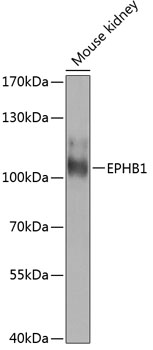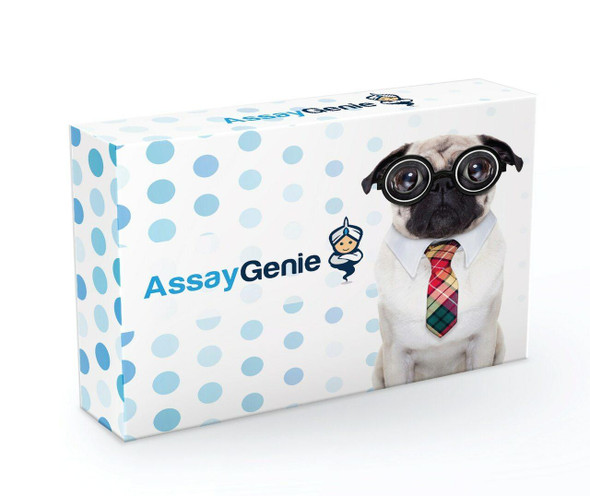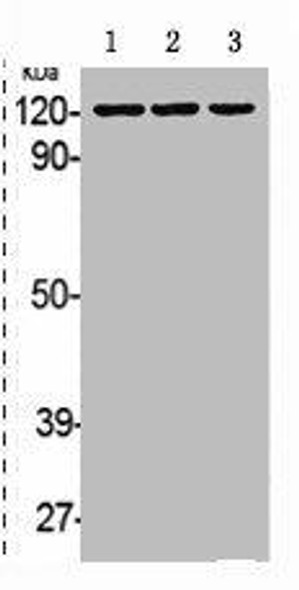Cell Biology Antibodies 12
Anti-EPHB1 Antibody (CAB8415)
- SKU:
- CAB8415
- Product Type:
- Antibody
- Applications:
- WB
- Reactivity:
- Human
- Reactivity:
- Mouse
- Host Species:
- Rabbit
- Isotype:
- IgG
- Research Area:
- Cell Biology
Description
| Antibody Name: | Anti-EPHB1 Antibody |
| Antibody SKU: | CAB8415 |
| Antibody Size: | 20uL, 50uL, 100uL |
| Application: | WB |
| Reactivity: | Human, Mouse |
| Host Species: | Rabbit |
| Immunogen: | Recombinant fusion protein containing a sequence corresponding to amino acids 260-500 of human EPHB1 (NP_004432.1). |
| Application: | WB |
| Recommended Dilution: | WB 1:500 - 1:2000 |
| Reactivity: | Human, Mouse |
| Positive Samples: | Mouse kidney |
| Immunogen: | Recombinant fusion protein containing a sequence corresponding to amino acids 260-500 of human EPHB1 (NP_004432.1). |
| Purification Method: | Affinity purification |
| Storage Buffer: | Store at -20'C. Avoid freeze / thaw cycles. Buffer: PBS with 0.02% sodium azide, 50% glycerol, pH7.3. |
| Isotype: | IgG |
| Sequence: | EPEN SVAC KACP AGTF KASQ EAEG CSHC PSNS RSPA EASP ICTC RTGY YRAD FDPP EVAC TSVP SGPR NVIS IVNE TSII LEWH PPRE TGGR DDVT YNII CKKC RADR RSCS RCDD NVEF VPRQ LGLT ECRV SISS LWAH TPYT FDIQ AING VSSK SPFP PQHV SVNI TTNQ AAPS TVPI MHQV SATM RSIT LSWP QPEQ PNGI ILDY EIRY YEKE HNEF NSSM ARSQ TNTA RIDG LRPG M |
| Gene ID: | 2047 |
| Uniprot: | P54762 |
| Cellular Location: | Cell membrane, Cell projection, Early endosome membrane, Single-pass type I membrane protein, dendrite |
| Calculated MW: | 26kDa/61kDa/109kDa |
| Observed MW: | 110kDa |
| Synonyms: | EPHB1, ELK, EPHT2, Hek6, NET |
| Background: | Ephrin receptors and their ligands, the ephrins, mediate numerous developmental processes, particularly in the nervous system. Based on their structures and sequence relationships, ephrins are divided into the ephrin-A (EFNA) class, which are anchored to the membrane by a glycosylphosphatidylinositol linkage, and the ephrin-B (EFNB) class, which are transmembrane proteins. The Eph family of receptors are divided into 2 groups based on the similarity of their extracellular domain sequences and their affinities for binding ephrin-A and ephrin-B ligands. Ephrin receptors make up the largest subgroup of the receptor tyrosine kinase (RTK) family. The protein encoded by this gene is a receptor for ephrin-B family members. |
| UniProt Protein Function: | EphB1: a receptor tyrosine kinase of the Eph family. Receptor for members of the ephrin-B family: ephrin-B1, -B2 and -B3. The Eph receptor tyrosine kinase family, the largest in the tyrosine kinase group, has fourteen members. They bind membrane-anchored ligands, ephrins, at sites of cell-cell contact, regulating the repulsion and adhesion of cells that underlie the establishment, maintenance, and remodeling of patterns of cellular organization. Eph signals are particularly important in regulating cell adhesion and cell migration during development, axon guidance, homeostasis and disease. EphA receptors bind to GPI-anchored ephrin-A ligands, while EphB receptors bind to ephrin-B proteins that have a transmembrane and cytoplasmic domain. Interactions between EphB receptor kinases and ephrin-B proteins transduce signals bidirectionally, signaling to both interacting cell types. Eph receptors and ephrins also regulate the adhesion of endothelial cells and are required for the remodeling of blood vessels. The ligand-activated form of EphB1 interacts with GRB2, GRB10 and NCK through their respective SH2 domains. Four alternatively spliced isoforms are known. |
| UniProt Protein Details: | Protein type:Protein kinase, TK; Kinase, protein; EC 2.7.10.1; Protein kinase, tyrosine (receptor); Membrane protein, integral; TK group; Eph family Chromosomal Location of Human Ortholog: 3q21-q23 Cellular Component: cytosol; early endosome membrane; extracellular region; integral to plasma membrane; plasma membrane Molecular Function:protein binding; transmembrane-ephrin receptor activity Biological Process: angiogenesis; axon guidance; cell-substrate adhesion; central nervous system projection neuron axonogenesis; detection of temperature stimulus involved in sensory perception of pain; ephrin receptor signaling pathway; establishment of cell polarity; neurogenesis; positive regulation of synaptogenesis; protein amino acid autophosphorylation; regulation of JNK cascade; retinal ganglion cell axon guidance |
| NCBI Summary: | Ephrin receptors and their ligands, the ephrins, mediate numerous developmental processes, particularly in the nervous system. Based on their structures and sequence relationships, ephrins are divided into the ephrin-A (EFNA) class, which are anchored to the membrane by a glycosylphosphatidylinositol linkage, and the ephrin-B (EFNB) class, which are transmembrane proteins. The Eph family of receptors are divided into 2 groups based on the similarity of their extracellular domain sequences and their affinities for binding ephrin-A and ephrin-B ligands. Ephrin receptors make up the largest subgroup of the receptor tyrosine kinase (RTK) family. The protein encoded by this gene is a receptor for ephrin-B family members. [provided by RefSeq, Jul 2008] |
| UniProt Code: | P54762 |
| NCBI GenInfo Identifier: | 1706663 |
| NCBI Gene ID: | 2047 |
| NCBI Accession: | P54762.1 |
| UniProt Secondary Accession: | P54762,O43569, O95142, O95143, Q0VG87, A8K593, B3KTB2 B5A969, |
| UniProt Related Accession: | P54762 |
| Molecular Weight: | 26,906 Da |
| NCBI Full Name: | Ephrin type-B receptor 1 |
| NCBI Synonym Full Names: | EPH receptor B1 |
| NCBI Official Symbol: | EPHB1 |
| NCBI Official Synonym Symbols: | ELK; NET; Hek6; EPHT2 |
| NCBI Protein Information: | ephrin type-B receptor 1 |
| UniProt Protein Name: | Ephrin type-B receptor 1 |
| UniProt Synonym Protein Names: | ELK; EPH tyrosine kinase 2; EPH-like kinase 6; EK6; hEK6; Neuronally-expressed EPH-related tyrosine kinase; NET; Tyrosine-protein kinase receptor EPH-2 |
| Protein Family: | Ephrin type-B receptor |
| UniProt Gene Name: | EPHB1 |
| UniProt Entry Name: | EPHB1_HUMAN |







